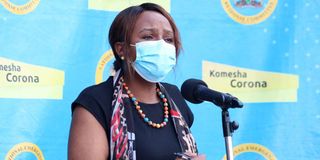Mombasa, Turkana virus surge worries experts

Health CAS Mercy Mwangangi speaking on September 15, 2020.
What you need to know:
- Mombasa has now registered 101 cases in the last four days.
- The percentage of people who test positive for the virus now stands at 4.4.
- There are inadequate resources at county level for surveillance.
Health authorities have raised concerns following a rise in the number of new coronavirus cases in Mombasa and Turkana counties in the recent past.
With very few infections in the past several weeks, Mombasa has now registered 101 cases in the last four days.
The Ministry of Health has sent teams of experts to investigate the developments in the two regions.
“Mombasa and Turkana were on a downward trend but Covid-19 cases have begun to shoot up. While this might seem like a surge, we have set up a team to find out why it is happening,” Health Chief Administrative Secretary Mercy Mwangangi said on Monday.
The percentage of people who test positive for the virus now stands at 4.4.
The country’s recovery rate of 63.8 per cent is, however, below the regional average, the World Health Organization Regional office for Africa (WHO-Afro) says.
Reduced contact tracing
In its latest report, the agency says reduced contact tracing and violation of public health measures, particularly by those using public transport, pose a danger to the country.
There are also inadequate resources at county level for surveillance, problems in the supply of reagents and personal protective equipment.
“These challenges, along with stigma against those known to have contracted the virus...need attention to keep the momentum of falling numbers,” it says.
According to the ministry, Nairobi still had the highest number of confirmed cases by Monday at 19,990, followed by Kiambu (2,634) and Mombasa with 2,603.
Nairobi and Mombasa recorded the highest attack rates of 454.6 and 215.4 per 100,000 people respectively, compared to the national rate of 76.
An attack rate is defined as the proportion of those who become ill after a specified exposure.
Attack rate
Dr Jeanette Dawa, an epidemiologist, said the attack rate is used to calculate chances of infection and death though it is not entirely representative of the situation as Mombasa’s population is lower than Nairobi’s.
Nairobi has the highest attack rate but chances of getting infected are higher in Mombasa.
A culture of social gathering, the prevalence of non-communicable diseases and low socio-economic status could explain the high numbers.
Most of the 89 Covid-19 deaths in Mombasa had lifestyle diseases like diabetes, hypertension, and heart ailments.
Mombasa Health Chief Officer Khadija Shikely earlier said the high number of diabetes, hypertension, asthma and heart diseases is worrying.
She attributed the conditions to “genetic make-up, lifestyle and lack of exercise as most locals prefer to use tuk tuks”.
Dr Eddy Odari Okoth, a virologist, cited cultural beliefs and poverty for failure to seek healthcare services.
Similarities between Covid-19 symptoms and those of mosquito-borne diseases like malaria, dengue and chikungunya, which are prevalent in Mombasa, prompt patients to downplay the illness.
Most common symptoms
Fever, muscle pain, dry cough and tiredness are some of the most common symptoms of coronavirus. These are also seen in chikungunya and malaria patients.
“The resulting assumption is that if you wait it out, the symptoms and eventually the disease will pass,” Dr Okoth said.
“One thing we have to accept with Covid-19 is that the dynamics of transmission keep changing but some things are constant. When you are asymptomatic, people are not suspicious. Given that Mombasa is humid, people tend to aggregate into cooler places, increasing chances of spreading the virus.”
Meanwhile, Kenya recorded 10 more deaths and 96 new cases, raising the infections to 36,301 and death toll to 634 yesterday.
Health Cabinet Secretary Mutahi Kagwe said Nairobi accounted for the majority of the cases at 15, followed by Kisii (10) and Busia (eight).
Mombasa, Uasin Gishu and Kisumu had seven each while Kericho had five, Kilifi and Samburu had four each.
There were two cases in Nakuru, Kajiado and Kiambu. Bomet, Embu, Kakamega, Makueni, Meru, Trans Nzoia, Narok and Taita-Taveta each had a case.
The country has conducted more than half a million tests.
Six of Nairobi’s cases were in Westlands, Roysambu had five, Lang’ata (four) and Embakasi seven. The rest were in Kasarani, Kibra, Makadara and Dagoretti.
Additional reporting by Vera Okeyo.





